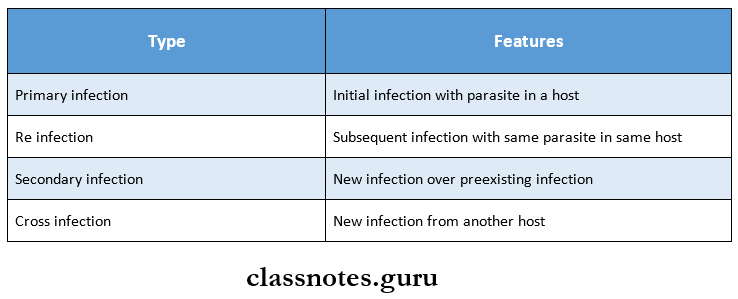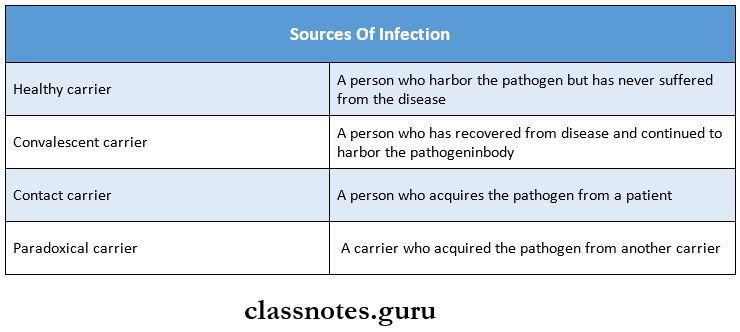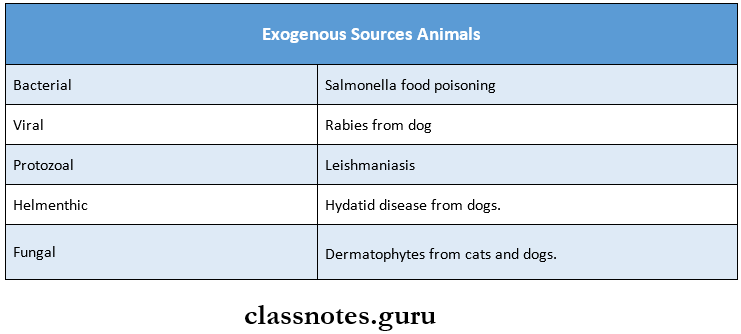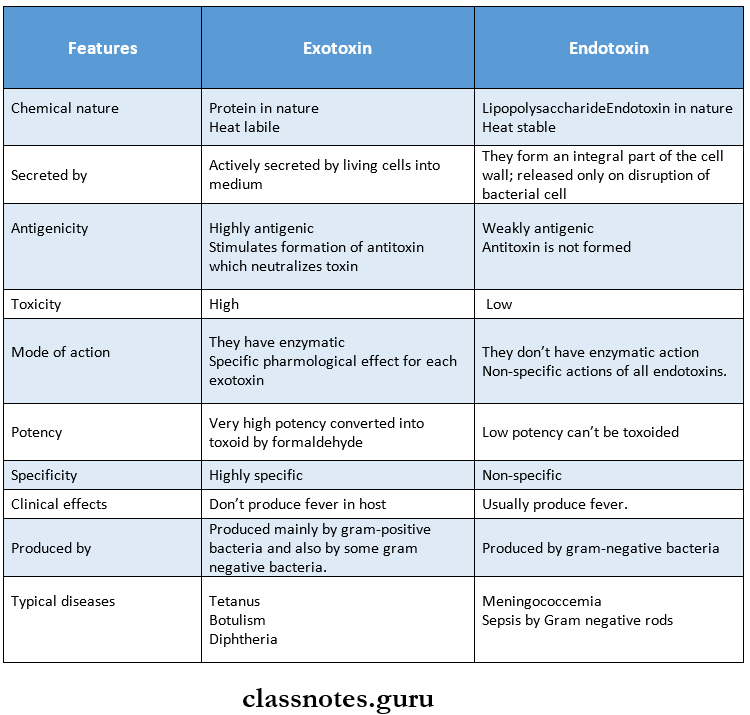Infection Important Notes
1. Types Of Infection

Read And Learn More: Microbiology Question and Answers
2. Sources Of Infection

3. Exotoxin
- Generally formed by Gram-positive bacteria
- Heat labile, highly antigenic, highly specific
- Inactivated by formalin
- Converts toxins into toxoids
4. Endotoxin
- Produced by Gram-negative bacteria
- Heat stable, less potent, nonspecific
- Cannot be toxoided
Infection Short Essays
Question 1. Modes of transmission of infection.
Answer:
Modes of Transmission Of Infection
1. Contact:
- It may be direct (or) indirect
- Infections spread by direct contact are sexually transmitted diseases such as syphilis, AIDS, and gonorrhea.
- A contagious disease is a term used for the disease acquired by direct contact
- Indirect contact may be through the agency of fomites which are inanimate objects such as clothing, toys, etc.
2. Inhalation:
- Respiratory infections such as the common cold, influenza, and T.B. are acquired by inhalation.
- These organisms are shed into the environment by patients in secretions from the nose (or) throat during sneezing, coughing (or) speaking.
3. Inoculation: In some instances, pathogens may be directly inoculated into the tissues of the host For Example: Tetanus spores in deep wounds, and rabies virus directly by bite of a rabid animal.
4. Ingestion: Intestinal infections like cholera, dysentery, food poisoning, and most of parasitic infections are acquired by ingestion of food (or) drink contaminated by pathogens.
5. Vectors:
- Vectors are anthropods or other invertebrate hosts Examples: are flies, ticks, and mosquitoes.
- Transmission by vector may be either mechanical or biological.
6. Transplacental Transmission: Some pathogens can cross the placental barrier and infect the fetus in utero. This is known as vertical transmission.
Transplacental Transmission Example. Teratogenic infections like rubella.
7. Iatrogenic And Laboratory Infections:
- If meticulous care in asepsis is lacking certain infections like AIDS and hepatitis B may sometimes be transmitted during procedures such as injections, lumbar punctures, blood transfusions, and surgery. These are known as iatrogenic infections.
- Laboratory personnel handling infectious material are at risk of infection transmission.

Question 2. Sources of infection?
Answer:
Sources Of Infection
Sources of infection may be endogenous (or) exogenous sources.
1. Endogenous Sources: Organisms of normal flora are usually non-pathogenic but occasionally they behave as pathogens outside their habitat.
Example: Virtdians streptococci (normal flora of mouth) can cause infective endocarditis.
2. Exogenous Sources:
- Most of the infections are exogenous In origin.
- Exogenous sources include.
- Human cases and carriers.
- Humans themselves are the most common source of infection.
- Animals.
- Human cases and carriers.

- Insects
- Blood-sucking insects such as mosquitoes, ticks mites, and flies may transmit several pathogens to man.
- Anopheles mosquito – malaria.
- Soil and water
- Spores of tetanus and gas gangrene bacilli remain viable in the soil for decades and serve as a source of infection.
- Food:
- Contaminated food acts as a source of infection in cases of food poisoning, diarrhea, and dysentery.
- Example: Food poisoning by staphylococcus.
- Insects
Question 3. Differences between Exotoxin and endotoxin.
Answer:
Differences Between Exotoxin And Endotoxin

Question 4. Nosocomial or hospital-acquired infections?
Answer:
Nosocomial Or Hospital-Acquired Infections
- Cross-infection acquired in hospitals is called hospital-acquired hospital-associated or nosocomial infection.
- They may manifest during their stay in the hospital or sometimes after the patient is discharged.
- They may spread through droplets infection, dust, skin scales, in animate sources.
- Direct spread through contact and indirectly through equipment and materials.
Nosocomial Infections And Causative Organisms

Prevention or Control of Hospital-Acquired Infections:
- Proper sterilization and disinfection of the inanimate objects.
- Control of route of transmission by regular washings of hands, and disinfection of equipment.
- Isolation of an infectious patient
- Administration of antibiotics and antiseptics to the carrier staff (or) source patient
- Vaccination to susceptible hosts.
